One of the (many) things I collect are vintage fans. I love looking at them and thinking of the parties they attended, the smiles they hid, and the dancers they cooled.
The Historical Sew Fortnightly ‘Accessorise‘ challenge seems like the perfect opportunity to show you two of my favourite fans from my fan collection.
It also gives me the excuse to (very, very belatedly) show you some of the gorgeous images of a model in my robe a la francaise holding one of the fans that Mandi Lynn of A La Mode Photography took for the Radio New Zealand photoshoot (remember the out-takes?). The photoshoot images were so fabulous that I thought “I’ll save them for something special” and then before I knew it a year and a half had passed. Sorry!
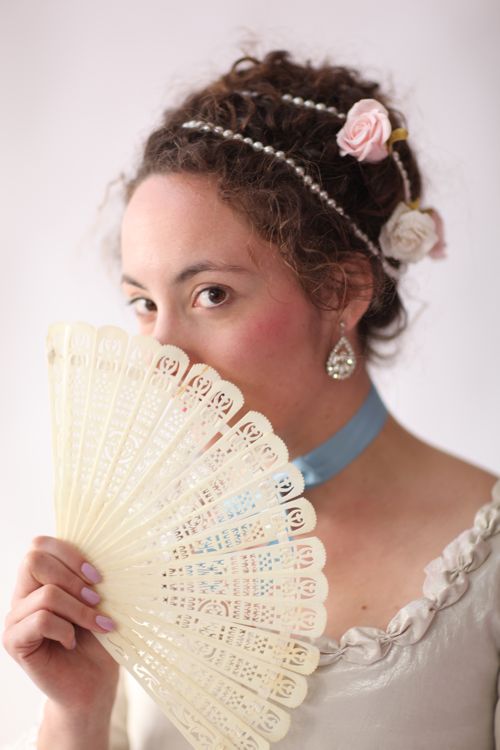
Isn’t she gorgeous? Isn’t the fan gorgeous? Aren’t the photos gorgeous!?!
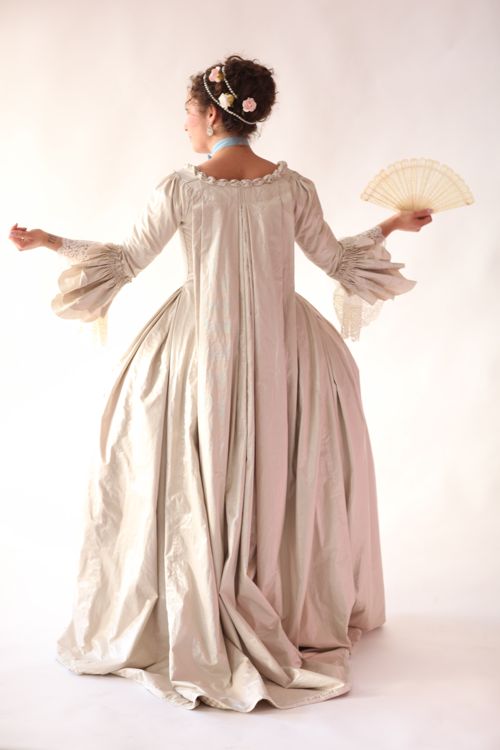
The first fan is a brise fan made of paper thin bone or ivory sticks carved with lacy patterns and joined together with a satin ribbon. It’s very similar to the sandalwood (or sandalwood scented) fans that you can still buy in Chinatowns in its design and construction.
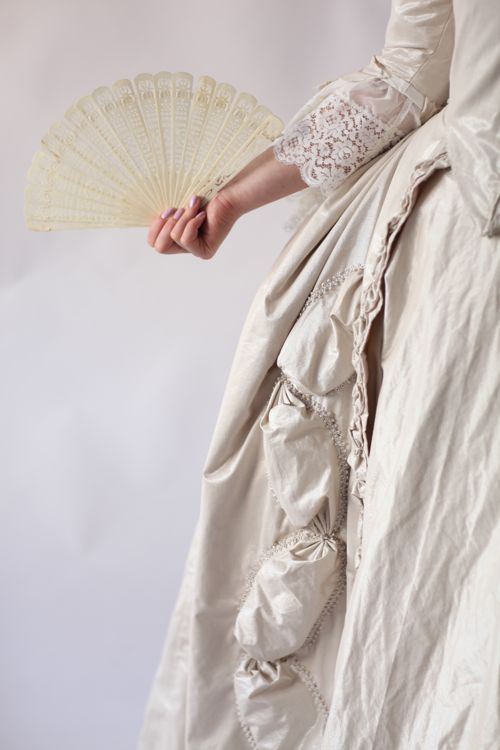
It probably dates from the early 20th century, and is robust enough to be held and used, though I wouldn’t use it for anything more energetic than a studio photoshoot. It’s clearly a bit of an anachronism to pair with an 18th century gown, but the delicate colours and shape worked well with the robe a la francaise aesthetically.
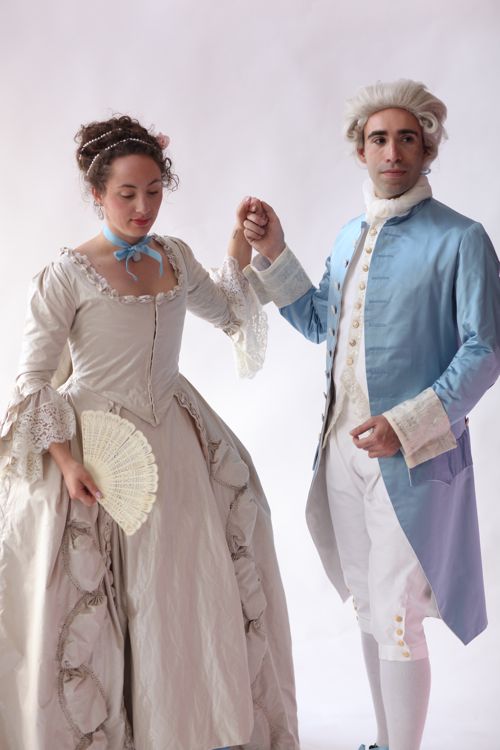
This fan was given to me by the darling and fabulous Emily of Ever So Scrumptious (also the genius behind my blog design) who already had a similar fan and thought I would get more use out of it than she would. Have I mentioned before that I have the best friends ever?
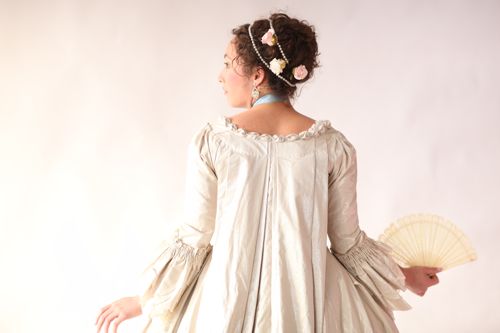
The second fan I want to show you was a gift from Mr D for our wedding anniversary.
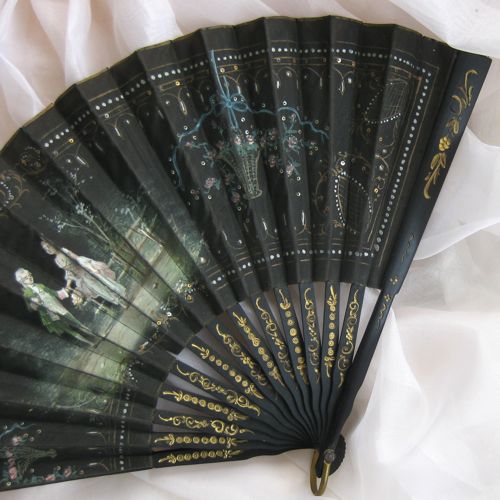
Mr D is a genius when it comes to anniversary gifts. He says “Darling, instead of bumbling around in a store and trying to find something that you’d like and probably getting it wrong, I’d like to have an experience and spend time with you. Why don’t we go to your favourite antique store and you can pick out something and that way we’ll have an afternoon together and you get something you want?” And we do this. And he even sort of enjoys the antique stores – looking at the weirder things, and getting excited about the sports memorabilia. How clever is he?

The antique store dated this fan to the late 19th century, but sometimes I think it could be as recent as the 1930s, and that era of Rococo revival. I may like fans, but I’m actually terrible at dating most of mine! They just aren’t textile-y enough.
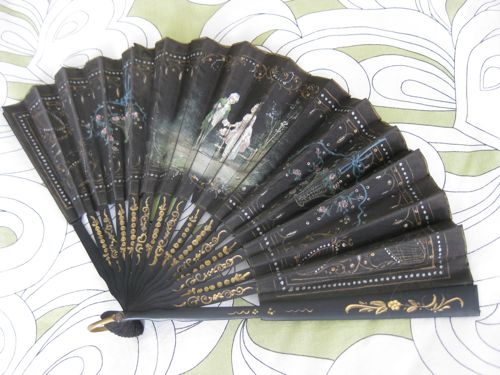
The fan is certainly a direct take on 18th century fans, with a central painting of a Rococo beauty and her besotted swain in shades of pink and green on the black paper background.
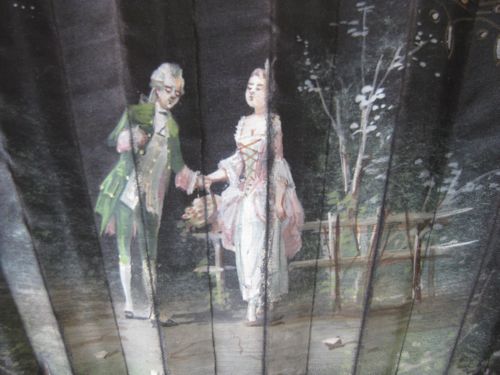
The fan is further embellished with delicate baskets, and tiny sewn-on sequins
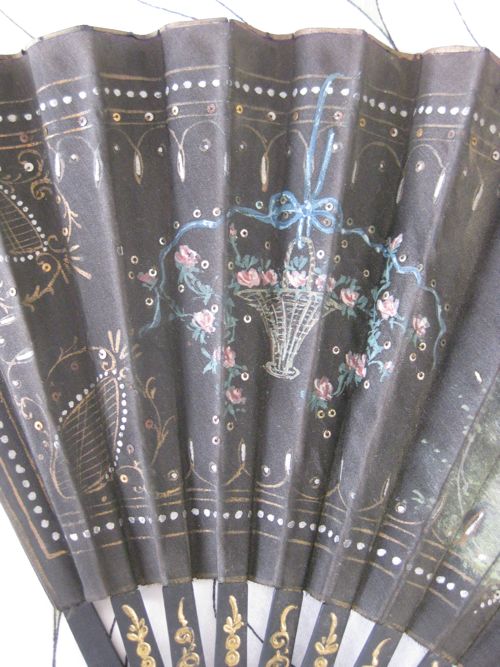
The painted paper is backed in black silk gauze, now very fragile and torn.
 The sticks are quite simple wooden sticks, painted black with gilt gold trim. It’s not impossible to find modern fans with similar sticks.
The sticks are quite simple wooden sticks, painted black with gilt gold trim. It’s not impossible to find modern fans with similar sticks.

Late 19th/early 20th century Rococo revival fan
Aren’t the both just gorgeous? I wish modern things were half as pretty!

I actually found a fan very similar to the second one in a charity shop not all that long ago! Thought it was a modern souvenir fan until I opened it. Sadly the leaf’s almost split down one of the folds but still, for £2.50 I wasn’t gonna say no… most of my fans are in terrible condition, but I do have a brise fan like your first one that was a present from the first fashion curator I knew as a friend… the ribbon has rotted, a few hand-painted satin fans from the late 19th century, and a lovely spangled gauze fan in its original box that I think is mid-19th century. (another bargain find – I still come over faint at the memory of the dealer just picking it up BY THE LEAF and waving it about…)
fancircleinternational.orgYou can fix that brise fan pretty easily!
http://www.fancircleinternational.org/text/restore.html
I did a spot of gluing on a brise fan I received from a relative that had one or two sticks broken, and it was suitable for display afterwards.
I’m so glad that you have enjoyed the brise fan I handed over, and that it’s fulfilled its destiny with 18th-century gowns.
I don’t think it’s Daniel’s brise fan that is broken. Sadly, it’s much harder to mend fabric fans (if you’d even want to, because, like me, Daniel comes from a museum background).
I do love that brise fan 🙂 Thank you so much for it!
So you’re a fan collector too! I knew I liked you for a reason. Do you have any ideas on the dates for these?
Ergh. Your story about waving the fan about. The things I have seen antiques dealers do!
Well, I only have a handful of fans – I’ve been collecting vintage and antique clothing since I was 10 though!
I see a LOT of the ivory/bone fans around – they must have been mass produced in their day. I’ve seen them dated anywhere from 1860s to early 1900s, but I could see them being produced well into the 1930s. They all have the exact same cutwork design too! My feeling is that 1900-1930 is probably as near as you can get and that perhaps these fans weren’t actually fashionable at any point ever, but were more souvenirs of the East…
My fan also does have one broken stick (but fortunately near the end so it doesn’t show too much).
I only have a half a dozen fans myself, but they still feel more like a discreet collection, because the vintage and antique clothing/textiles aren’t really arranged around a theme, they are just pieces that came my way. I’ve been trying to collect more to a theme in the last few years – I’ve got a collection of ‘South of the Border’ textiles and clothes, and another one showing Asian influence. Pretty basic, but at least they make sense if displayed.
I agree with you about the fans. They are the earlier equivalent of the sandalwood fans that you can still buy today, but which have been produced and sold since at least the 1960s – so going on 50 years now. And with only about four different patterns in their cutwork designs!
As a matter of interest, how would you feel about gluing your broken stick (with conservator grade glue)?
If I had the missing part of the stick, I might consider it – but actually, I just hide the broken stick behind one of the other (unbroken) sticks when I open the fan…. it barely shows.
I agree with your date. There was one at the museum where I was working that was very similar, but white – sadly, it was in much worse condition, all to pieces.
My date for which fan? And which date?
I shall endeavor to take very good care of mine, so that if they ever do end up in a museum they will be in as good condition as when I got them 🙂
So beautiful! Fans are darn useful things, I have a selection of cheapies I take dancing to cool off between spells on the dance floor. (Because stuff that “glowing” rubbish, I get hot and sweaty!) None quite this pretty but I won’t mind if they get lost or damaged.
Interesting that you called the parts “sticks”. I always thought they were staves. Are the words used interchangeably, or are staves from a specific type of fan, or am I just wrong?
Totally agree: fans are wonderful things!
The museums I’ve worked at used ribs as their preferred terminology (yes, I went and pulled out my old terminology manual to check!). The sticks are only the lower part, below where the fan leaf is attached, and the upper parts where the fan leaf is attached are called slips (so technically I was incorrect in referring to the whole thing as sticks). The outer ribs are guardsticks
I’m not sure what you would call the pieces of a brise fan – are they ribs, sticks or individual leafs?
Staves is a new one to me as applied to fans (though a stave is a stick, so I see where it came from), and isn’t in my manual. If the internet is anything to go by, the term seems to be used predominantly by the burlesque community.
So it looks like we were both right and wrong?
Anyone else want to weigh in?
That’s awesome, thanks! I did wonder if staves were specific to feather fans, which are more like brise fans (thats a new word for me to) in that there is no leaf. I had no idea that there are names for so many many bits of a regular fan.
Both are really gorgeous, but that second one with the tiny sequins – be still my beating heart!
Isn’t it fantastic! Mr D was a little dubious (He said “but it’s torn!”) but it makes me happy just to look at it!
They’re both pretty! I only have a very damaged probably Chinese fan I found in the street one January day when it was very, very, very windy…
Thank you! I think the brise fan may have been made in China or Japan, as many were in the late 19th and early 20th century. What does your fan look like? And what a funny way to find it!
I think it’s modern; anyway, it has wooden (or wooden-like) sticks (or ribs, or whatever 🙂 ); some are broken. The construction is very similar to your black one, though it’s simpler (normal brown/beige wood, no gold).
The leaf is fabric, printed – it’s so dirty/discoloured that it’s very difficult to make out what the print was exactly, or what the original colour was, but it looks like green with some colourful flowers and it definitely has a silver printed edge on top. It, obviously, does not look so very pretty now, but yes, it was a funny way to find it and I just had to keep it because it’s still obvious that it must have been pretty before the wind and mud and whatnot. 🙂
And now that I describe it, I realise it actually looks more like Japanese to me…
the info about the fan’s is interesting but I love the dress more.
Thank you! I do love that dress. I’d do it differently if I did it again, but I still love it!